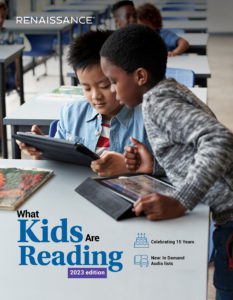February 4, 2016
“Please see if I am grokking this properly.” (Angel, 2016)
Admit it, before reading further, you thought about jumping to Google, dictionary.com, or even Wikipedia to see what “grokking” is, and more importantly, to learn what is required to grok properly. Your moment of cognitive uncertainty is at the heart of Vygotsky’s work on vocabulary acquisition and cognitive development. Although we most often associate Vygotsky with the zone of proximal development, his theories on language establish his continuing place in human development research. Vygotsky considered language the “social means of thought” (1986, p. 94) and posited that intellectual growth reflects the depth of language mastery.
The interdependent relationship Vygotsky described between cognitive development and vocabulary was brought to light in the classic 1965 Hart & Risley study which found that language acquisition between seven months through age three is an accurate predictor of academic achievement in the intermediate grades. The study looked at the relationship between amounts of talking across three broadly defined socioeconomic groups—poverty, working class, and professionals.
Talkativeness explains variance in achievement levels
Some have overgeneralized the findings to state that poverty causes lower achievement levels; however, the findings are clear: talkativeness explains the variances in achievement levels among young children. As Risley (2013) stated, “When we begin to look at outcome in terms of child vocabulary size, it wasn’t SES [socioeconomic economic status]; it was talkativeness. So we could sort it out. In other words, the relationship between amount of talking and child vocabulary size and child IQ test scores was large, and there wasn’t anything left over once you took that out—once you took out the amount of talking—there was no SES or race left [to explain differences in child IQ scores].”
That particular finding bears repeating. Without consideration of the talkativeness variable, there is not enough power in either the SES or race variables to explain achievement differences among children. The power is in words. Vygotsky considered words as critical for intellectual growth—explaining that the central moment in conceptual development is the use of words as functional tools (1978). More than three decades after Vygotsky’s death, and at a time when his writings were largely inaccessible outside the Moscow library, Hart & Risley quantified his theories. By the age of four, the correlation between talkativeness and children’s intellectual outcome is “as strong as the measures will allow” (Risley, 2013).
Vocabulary exposure impacts language acquisition
Establishing that talkativeness in the pre-school years fosters achievement and that words build concepts during the at-school-and-beyond years, the focus shifts to ways educators build each student’s toolkit throughout their everyday experiences at school. How do we fill their days with words?
What Kids are Reading illustrates data from 9.8 million students who read over 334 million books and nonfiction articles during the 2014-2015 school year. The report shares insights on key aspects of student reading practice—including the number of words they are reading. This is important because the amount of vocabulary exposure during reading has been documented to impact language acquisition (Anderson & Nagy, 1993). The researchers estimate that children learn 2,000–3,000 new words per year at school, yet direct instruction accounts for about 300 of those words. Engagement in independent as well as strategically-guided reading impacts vocabulary development. This is not to say that explicit instruction should be abandoned. Quite the contrary— explicit instruction is so critical that it should be supported by day-to-day conversations about words being learned and wide reading to develop supporting vocabulary and concepts.
As Vygotsky describes, learning words in isolation may lead to the development of pseudo-concepts. Explicit instruction, without context, supplies the ready-made meaning of words. For example, a whale looks like a fish and lives in the ocean; therefore, a whale is a fish. This is a pseudo, or “shadow” concept. Explicit instruction, coupled with a range of experiences about whales, including wide reading and conversation, guides children to develop not only a rich concept of a whale, but deeper meanings of mammals, marine life, and ecosystems.
Narrative text matched to reading level increases vocabulary
What Kids are Reading data explain that first graders encounter about 26,000 words in texts they read. Anderson and Nagy (1993) write that the probability a student will learn a previously unfamiliar word are one in twenty of the total words read, if the student is reading narrative text matched to reading level. This means that first graders described in What Kids are Reading likely increased their functional toolkits by 1,300 words via independent reading. Certainly some of those books include rich vocabulary about whales. By grade 6, students read about 440,000 words. Do the math.
Speaking of math, Anderson and Nagy (1993) report that about 18% of words encountered in instructional text are unique and unfamiliar. Through reading instructional texts—independently and with scaffolding—students will acquire about one of twenty of those words. To put that to work, this blog post is 889 words and readability statistics put it at grade 12.1. Assuming this is within your reading range, there is the potential that you gained eight previously unfamiliar words while reading. If you read with interest, empathy, and a desire to establish rapport so that you could communicate effectively, you most likely grokked all that was shared.
References
Anderson, R., & Nagy, W. (1993). The Vocabulary Conundrum. Center for the Study of Reading, University of Illinois, Urbana-Champaign, IL. Retrieve 01/24/16 from https://www.ideals.illinois.edu/bitstream/handle/2142/18019/ctrstreadtechrepv01993i00570_opt.pdf.
Angel, M. (personal communication, 01/14/2016).
Hart, B. & Risley, R. (1995). Meaningful Differences in the Everyday Experience of Young American Children. Paul H. Brookes Publishing Company. Baltimore, MD.
Renaissance Learning (2016). What Kids are Reading. Retrieved 01/24/2016 from https://www.learnalytics.com/insights/wkar2016.
Risley, T. (2013). Meaningful Differences in the Everyday Experiences of Young American Children [Video file]. Retrieved 01/24/2016 from http://www.childrenofthecode.org/Tour/c3b/differences.htm.
Vygotsky, L. (1986). Thought and Language. The MIT Press, Cambridge, MA.
Vygotsky, L. (1978) Mind in Society: The Development of Higher Psychological Processes. Harvard University Press, Cambridge, MA.
Learn more
Looking to develop your students’ reading habits? Explore Renaissance Accelerated Reader.


